Enhancing Tomato Growth: Potting Tips and Techniques


Intro
Growing tomatoes can be one of the most rewarding experiences for any gardening enthusiast. However, the success of these beloved plants hinges on various factors, particularly potting strategies. Whether you're a green-thumbed novice or an experienced gardener, understanding the nuances of potting can dramatically influence your tomato yield.
In this guide, we will explore essential aspects, such as the optimal spacing and suitable pot sizes for diverse tomato varieties. Decisions around potting are vital, as the spacing and number of plants per pot can significantly impact their health and productivity. Let’s dive into a thoughtful analysis of what you need to know to maximize your tomato plant growth.
The Importance of Pot Selection
Choosing the right pot is akin to selecting a home for your tomato plants. The dimensions of a pot can affect how much room the roots have to grow, which in turn influences the overall vigor of the plant. Both the material and size of the pot you select play crucial roles in the growth of your tomatoes.
Material Matters
The material of the pot affects not only aesthetics but also functionality. Common options include:
- Plastic: Lightweight and affordable, ideal for beginners.
- Clay: Offers excellent breathability but can dry out quickly.
- Ceramic: Heavy and often beautifully designed, they retain moisture well but are harder to move.
- Fabric: Good drainage with aeration benefits, allowing for healthier root systems.
When picking a pot, consider your local climate. If you're in a hot area, darker pots may overheat, while lighter pots reflect sunlight better.
Understanding Sizes
The size of the pot is another critical consideration.
- For small varieties like cherry tomatoes, a pot with a depth of at least 12 inches is often sufficient.
- Larger indeterminate varieties can require pots ranging from 18 to 24 inches in depth and diameter.
It's worth noting that planting too closely can lead to competition for nutrients and water, significantly diminishing your harvest.
Spacing Strategies
Proper spacing is not merely a matter of aesthetics; it’s fundamental to the health and productivity of the plants. Crowding can lead to a host of problems, including poor air circulation and increased susceptibility to disease. Each tomato species might have varying spacing needs:
- Bush Tomatoes: Generally require about 12 to 18 inches apart.
- Vine Tomatoes: Should have at least 24 to 36 inches of space between them.
Experimenting with these distances can help you find what works best in your specific conditions.
The Challenge of Container Gardening
While growing tomatoes in pots has its benefits, it also presents specific challenges that need to be tackled:
- Watering: Container-grown tomatoes typically need to be monitored closely. They can dry out faster in pots than in the ground.
- Nutrient Management: Pots limit the natural nutrient supply, which means you’ll need to amend and fertilize more frequently.
"Container gardening requires commitment. The benefits, however, are priceless—like having fresh tomatoes at arm’s reach."
End
Proper potting strategies robustly influence tomato plant growth. From selecting the appropriate materials and sizes to understanding proper spacing and recognizing the unique challenges of container gardening, the knowledge outlined in this guide positions you for abundant yields. Stay tuned for more in-depth sections addressing plant care techniques and seasonal considerations to support your gardening quest!
Understanding Tomato Plant Requirements
For anyone who has dabbled in gardening, it’s clear that understanding the essential needs of a plant is foundational for success. When it comes to tomato plants, this rings especially true. These gardening staples are not just any old plants; they thrive under specific conditions that can make or break their growth. Recognizing what tomatoes need—be it nutrition, water, light, or temperature—allows gardeners to set the stage for a flourishing crop.
Nutritional Needs of Tomato Plants
Tomato plants, being quite demanding in terms of nutrition, require a balanced feed of minerals and nutrients. These plants thrive best in rich, organic soil that’s loaded with essential elements. Here’s a closer look at what makes tomatoes tick:
- Nitrogen: This nutrient is essential for vegetative growth. However, too much nitrogen can lead to lush foliage while neglecting the fruits. It’s a tightrope walk—balance is key.
- Phosphorus: Crucial for root development and flowering—essential in the blooming stage where fruit formation begins.
- Potassium: It supports overall plant health and enhances the taste of the tomatoes. Good potassium content can lead to sweeter tomatoes, which is certainly a plus for any gardening enthusiast.
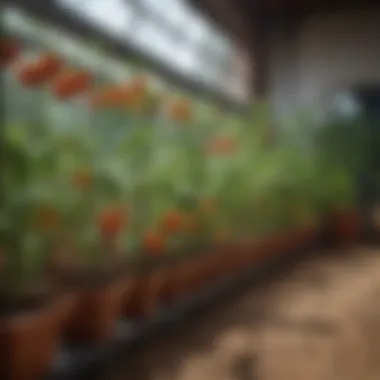
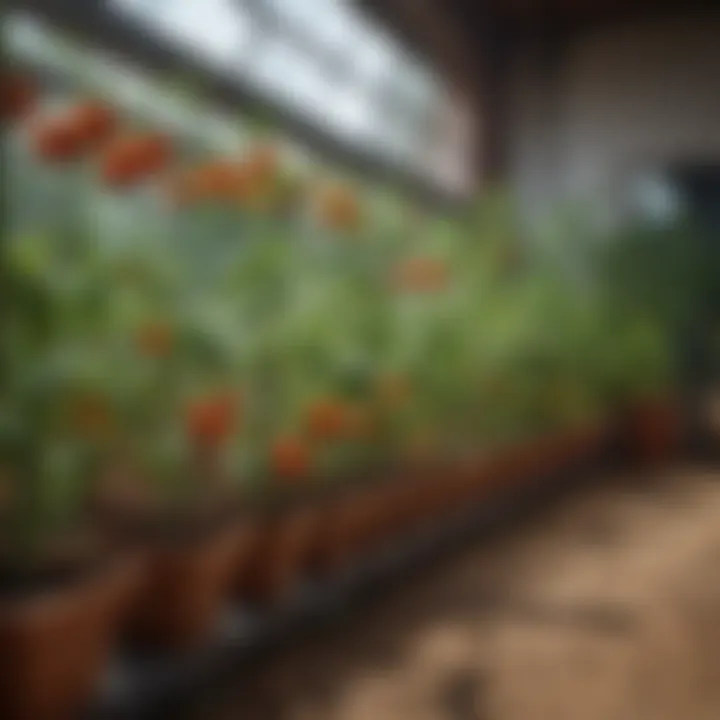
It's invaluable to incorporate compost or well-rotted manure into the potting mix to provide these nutrients effectively. Doing so not only improves soil structure but also enhances moisture retention, allowing plants to draw in the nourishment they need without excessive watering.
Watering Considerations
Watering can often be seen as a mundane task in gardening, but for tomato plants, it’s akin to providing lifeblood. Tomatoes prefer consistently moist soil; they don’t take kindly to extremes—overwatering can lead to root rot, while underwatering can stress the plants. Keeping the soil evenly moist is the goal.
- Watering Schedule: Early morning is the prime time for watering; it reduces evaporation losses and ensures the plants can take up water before the heat sets in. Depending on climate, a deep soak once or twice a week can do wonders.
- Drainage: Using pots with appropriate drainage holes is essential. If the water can't escape, the roots could drown, which would be a disaster.
- Mulching: A layer of mulch aids in moisture retention and temperature regulation, providing a buffer against rapid evaporative losses.
"Consistent moisture is your tomato's best friend; neglect it at your own risk!"
Light and Temperature Preferences
Tomato plants are sun-worshippers, always reaching for that golden light. Ideally, they thrive in full sunlight for at least six to eight hours a day. This intense light exposure initiates photosynthesis, facilitating robust growth and abundant fruit production.
However, it’s not just about the light; temperature plays a critical role too. Tomatoes prefer warm conditions. Here’s a quick reference regarding temperatures:
- Ideal Night Temperatures: Around 55-70°F (13-21°C) encourages healthy growth.
- Day Temperatures: Ideally, keep the day temps around 70-85°F (21-29°C). If it's too hot, the flowers may drop, and that’s counterproductive.
- Frost Awareness: Tomatoes are extremely sensitive to frost. Planting should happen once the danger of frost passes.
In sum, equipping oneself with this knowledge about tomato plant requirements allows gardeners to cater specifically to their needs, leading to healthier plants and better yields. Understanding these fundamentals sets the groundwork for success in container gardening.
Evaluating Pot Sizes for Tomato Plants
Selecting the right pot size for tomato plants is a pivotal step in ensuring their growth is not stunted and that they thrive, especially when container gardening. A tomato plant requires enough space to develop a healthy root system, which is vital for nutrient uptake and overall plant health. When evaluating pot sizes, gardeners must consider several factors, including the tomato variety, expected growth, and specific cultivation methods. Poor pot choices can lead to root binding or inadequate drainage, both of which could jeopardize the plant's health.
Common Pot Sizes and Their Applications
Determining the appropriate pot size can be as straightforward as understanding the basic sizes available and their implications. Common pot sizes for tomatoes typically include:
- 4-6 inches: Small starter pots, ideal for seedling stages. Limited soil volume means they need frequent watering.
- 10-12 inches: Moderate-sized pots suitable for compact varieties like cherry tomatoes. These cracks are just enough for roots to spread.
- 14-16 inches: Larger pots that can house determinate varieties, accommodating moderate root systems and improving moisture retention.
- 18-24 inches: Recommended for indeterminate varieties, providing ample space for extensive root systems. Great for larger plants and ensuring maximum yield.
Using the correct pot size can have a direct impact on productivity. If a pot is too small, the roots may outgrow their confines, and the plants can suffer from lack of nutrients and water. Conversely, an overly large pot can lead to water retention issues, contributing to root rot.
Assessing Drainage Needs in Pots
Proper drainage is essential for healthy tomato plant growth. Waterlogged roots can drown plants, leading to diseases that may spell doom for your harvest. While considering potting, it’s crucial to evaluate drainage options. Here are a few key aspects to take into account:
- Drainage holes: Ensure pots have multiple drainage holes at the bottom. Bigger holes allow for better water escape, preventing excess retention.
- Drainage materials: Placing a layer of gravel or clay pellets at the bottom of the pot can enhance drainage and prevent soil from clumping.
- Soil composition: Using well-draining potting mixes, often containing perlite or vermiculite, helps maintain the balance of moisture without waterlogging.
In gardening, it is key to strike the perfect balance between water retention and drainage. A quote that captures this sentiment well reads:
"It's not just what you grow, but how you grow that determines your success in gardening."
Thus, taking the time to understand pot sizes and their drainage capabilities can significantly optimize the health and productivity of tomato plants. Adequate potting strategies pave the way for lush foliage and bountiful fruits.
Determining How Many Plants per Pot
When it comes to potting tomatoes, deciding how many plants to grow in each pot isn’t merely a matter of aesthetics; it significantly affects the health and productivity of your plants. Each tomato plant—a priority for both the home gardener and the seasoned green thumb—has its own space, nutrient, and light requirements. Overcrowding leads to competition for these essential resources, which can prevent any of the plants from flourishing. Thus, it becomes crucial to grasp the elements that come into play when determining the optimal number of tomato plants per pot.
Factors Influencing Plant Density
Tomato Variety Characteristics
The type of tomato you choose matters more than you might think. Each variety has unique growth habits and characteristics that can dictate how many can cohabitate a single pot. For instance, indeterminate tomato varieties, such as ‘Beefsteak’ or ‘Cherokee Purple,’ keep growing taller and can spread out quite a bit, often requiring more room. They’re often loved for their rich flavors and heavy yields, but their sprawling growth can lead to cramped situations if potting space isn't considered carefully. Consequently, these varieties are less suitable for tighter plant density strategies.
On the other hand, determinate varieties like ‘Roma’ or ‘Bush Beefsteak’ have a more compact growth habit. They reach a certain height and stop growing, making them an easier choice for planting multiple specimens in one pot. Their bush-like tendency can reduce competition for light and nutrients, although it is essential to still give them adequate spacing to thrive.
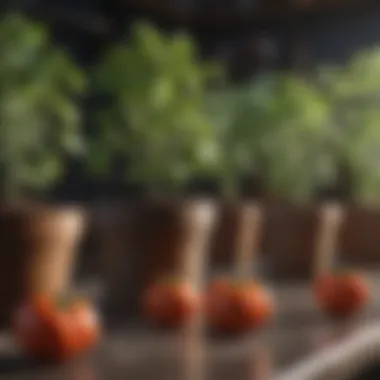

Climate and Weather Conditions
Weather plays a pivotal role in how plants grow, and tomato plants can be quite picky when it comes to their preferred climate. If you’re dealing with a hot and humid setting, overcrowding plants can exacerbate issues like fungal diseases. The reason is that poor air circulation helps promote conditions that these pathogens love. Thus, understanding the climate where you live is vital for deciding how many plants fit comfortably in your pots.
Moreover, if you're in a cooler climate where growing seasons are short, it might be better to plant fewer tomatoes in each pot, allowing them to get as much warmth and light as possible. This approach can maximize growth over a limited timeframe. Growth rates can vary widely, so keeping a close watch on climate conditions is a key factor in achieving optimal plant density.
Soil Quality and Nutrient Availability
Soil isn’t just dirt; it’s a living ecosystem that plays a substantial role in how well your tomatoes will thrive. Higher-quality soil can better support more plants since it’s full of nutrients and beneficial microbes. If your potting mix is rich in organic matter and provides easy drainage, then it can likely sustain a higher density of plants.
Conversely, less nutritious soil or packed soil can limit the growth potential of your tomatoes, slowing down their development and inhibiting yields. Poor soil compaction can lead to root rot, a challenge that arises when moisture doesn’t drain properly. That's why testing soil quality before planting can go a long way in determining how many plants should be in a pot.
Guidelines for Single vs. Multiple Planting
The decision to plant either one or several tomato plants in a pot should rest on the balance between maximizing yields and ensuring optimal plant health. If you lean towards single planting, you are more likely to yield larger fruits and a healthier plant overall, as it can fully access its nutrients, light, and space.
However, when capacity allows, consider grouping compatible varieties together in a larger pot to create an efficient and visually appealing display. Just keep in mind the factors discussed above: depth of the pot, type of tomato variety, and the local climate.
Ultimately, this balance is key. As you delve into the world of container gardening, being mindful of these plant density dynamics can lead you on the road to a flourishing tomato harvest.
Best Practices for Potting Tomatoes
When it comes to nurturing tomato plants in pots, the best practices can make a world of difference. Proper potting techniques not only enhance plant growth but also influence the yield, longevity, and overall health of the tomatoes. An emphasis on these practices helps gardeners embrace a more effective method to cultivate their plants, ensuring they have everything they need to thrive.
Techniques for Transplanting
Transplanting tomatoes correctly is key to fostering strong plants ready for a bountiful harvest. First and foremost, timing is essential. A gardener should aim to transplant seedlings when the threat of frost passes, ensuring the young plants are set in a welcoming environment.
Steps for Successful Transplanting:
- Preparation: Before transplanting, harden off the seedlings. This gradual exposure to outdoor conditions can reduce transplanting shock. During this time, place them outside for a few hours each day, increasing the duration over the span of a week.
- Choosing the Right Pot: Use a pot that is large enough to give roots room to stretch but not so large that the plant gets lost in excess soil.
- Plant Depth: When planting, bury the seedlings deeper. This encourages the main stem to develop additional roots, strengthening the entire plant structure.
Being vigilant about watering during this period can’t be overstated. Both under-watering and over-watering can lead to stress and stunted growth. Using a well-draining potting mix provides a solid foundation for healthy development.
Supporting Tomato Plants in Pots
Once transplanting is out of the way, the next priority is supporting the plants as they grow. Tomatoes can reach impressive heights, and maintaining their stability is beneficial for both plant health and ease of harvest.
Staking and Caging Methods
One of the most popular choices for supporting tomato plants is through staking or using cages. These methods offer essential structural support, allowing plants to grow upright. Staking involves inserting a sturdy stake into the pot beside the tomato and gently tying the plant to it as it grows. This method’s key characteristic is its simplicity, making it accessible even for novice gardeners.
In contrast, cages provide a wider support base. They encircle the plant, allowing branches to grow through without is restricting them. Cages can be particularly advantageous in windy areas, reducing the risk of damage.
Advantages of Staking and Caging:
- Improved Airflow: Prevents overcrowding of leaves, facilitating better air circulation which can hinder pest issues.
- Ease of Harvest: Keeps the fruits off the ground, making it easier to spot and harvest ripe tomatoes.
Disadvantages:
- Stakes may need adjustment: Staking typically requires more hands-on management as the plant grows, potentially requiring constant re-ties.
- Space Consumption: Cages can take up quite a bit of room, influencing how many pots you can place in an area.
Managing Plant Growth
Managing how tomatoes grow in pots is a holistic approach that encompasses both physical support and pruning techniques. The essence lies in how to contain the growth without sacrificing yield. A critical aspect of managing plant growth includes regular pruning to remove suckers. These small shoots can sap energy from the main stem, diverting nutrients away from the larger fruits.
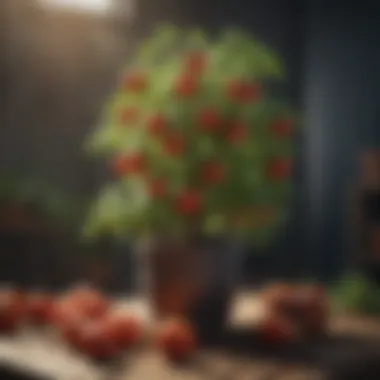
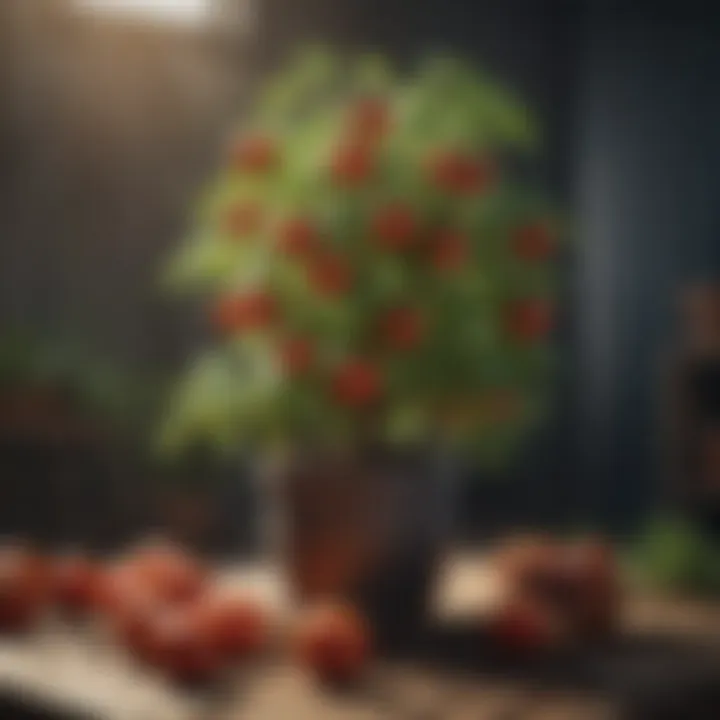
Another method is to ensure the plants have an adequate volume of potting medium. A larger volume allows for more nutrients and moisture retention, thereby supporting overall growth. The key characteristic of managing growth is the balance it creates between energy distribution and plant health. Properly managed tomatoes can produce more fruit, longer.
Advantages of Effective Growth Management:
- Increased Yield: A well-managed plant can produce a higher quantity and better quality of tomatoes.
- Simplified Maintenance: Less overgrowth results in an easier-to-manage garden, which can be critical for busy gardeners who may not have the time for constant monitoring.
Disadvantages:
- Time Consuming: Pruning and monitoring growth can require additional time that some may struggle to provide.
- Potential for Mistakes: Inexperienced gardeners might remove the wrong branches, affecting potential yield if not done carefully.
Remember, the right techniques and supports tailored to your specific conditions can mean the difference between struggling and flourishing tomato plants!
Common Challenges in Container Gardening
Growing tomatoes in pots is not all sunshine and rainbows; it comes with its own set of hurdles that can leave even the most seasoned gardeners scratching their heads. Understanding these challenges is crucial for ensuring healthy plants and productive yields. One can’t simply plop a tomato seedling in a pot and call it a day. Containers can restrict growth, influence watering needs, and affect nutrient availability. This section delves into pest challenges and disease management, focusing on proactive strategies and practical information that every container gardener should embrace.
Pest Management Strategies
Pests are a gardener's worst nightmare, especially in container gardening. They can invade swiftly, exploiting the confined space and the relatively sheltered environment that pots provide. Some common culprits include aphids, spider mites, and whiteflies. Their small size can make them tricky to spot, so regular inspections are key.
Here are some effective pest management strategies:
- Regular Monitoring: Check your plants frequently. Look for any signs of pest infestation, such as discolored leaves or sticky residue.
- Natural Predators: Release beneficial insects like ladybugs that naturally consume aphids. This creates a balanced ecosystem in your garden.
- Neem Oil: This organic pesticide is derived from the seeds of the neem tree and repels a wide range of pests. Make certain to follow the instructions for mixing and application.
- Companion Planting: Certain plants can deter pests. For example, marigolds are known to repel nematodes and other pests, providing an extra layer of defense in your tomato container.
It's important to adopt an integrated approach to pest management, using both preventative and reactive strategies.
Addressing Disease in Tomatoes
Container gardening could potentially increase the risk of diseases due to crowded roots and inconsistent watering. Fungal infections like powdery mildew and root rot usually set in quickly if you're not careful. Additionally, bacterial infections can wreak havoc if not noticed in time. Here’s how to tackle these issues effectively:
- Proper Spacing and Setup: Avoid overcrowding your pots. Give each plant enough room to breathe and develop. This aids in reducing humidity around the leaves, which can promote fungal growth.
- Quality Soil: Choose high-quality, well-draining potting soil. This can prevent water from accumulating at the bottom and creating a breeding ground for root rot.
- Watering Wisely: Ensuring consistent moisture is critical. Allowing the soil to dry out completely can put stress on plants, increasing susceptibility to disease.
- Crop Rotation and Hygiene: If you're reusing pots, ensure they are thoroughly cleaned. Disease spores can linger in soil or on container surfaces. Rotate crops whenever possible to disrupt disease cycles.
"Prevention is better than cure" remains a valid adage in gardening. These strategies lay a strong foundation for robust disease management in your tomatoes.
In container gardening, being proactive about pest management and disease prevention means fewer headaches down the line and ultimately, more fruitful and vibrant plants. These challenges may seem daunting, but with diligence and the right strategies, your tomato plants can thrive despite them.
Closure and Final Thoughts
As we come to the end of this exploration into optimizing tomato plant growth through practical potting strategies, it becomes clear that understanding the intricacies of how and where to plant your tomatoes can make or break your gardening efforts. The decision about spacing and selected pot sizes plays a pivotal role, not just in determining the health of each plant, but also in maximizing the yield and overall success of your gardening adventure. While it may seem like a minor detail, the right balance of space ensures that each plant accesses the nutrients, light, and water necessary for thriving.
Several key factors have emerged throughout this discussion. It's vital to recognize how the unique characteristics of different tomato varieties inform the choice of pot size and plant density. Varieties with sprawling vines, like heirlooms, may require wider pots and more space between plants than compact varieties such as determinate tomatoes. This tailored approach allows the plants to flourish without competing for essential resources.
Moreover, a comprehensive grasp of watering considerations and nutrient management leads to a more robust garden. Well-drained pots minimize waterlogging while retaining enough moisture to sustain the plants through hot summer days. Techniques like mulching can further support our efforts in maintaining moisture levels and promoting healthy soil.
Lastly, sustainable practices aren't just a trend; they can make a significant difference in your gardening environment. By fostering biodiversity, enriching the soil naturally, and reducing reliance on chemical fertilizers, you'll not only grow healthier plants but also contribute positively to the eco-system. This holistic approach is not just about immediate benefits; it's a long-term investment in the health of your garden, your local environment, and the food you consume.
"Gardening is a way of showing that you believe in tomorrow." – Unknown
In the grand scheme, consider these insights and best practices not just as guidelines for your current gardening season but as a foundation for future endeavors. With a little patience and attention to detail, every gardener—whether novice or experienced—can enjoy the fruits of their labor in the form of delicious, home-grown tomatoes.
Recap of Key Insights
To encapsulate the essence of what we have covered:
- Understanding Plant Needs: The nutritional, water, and light needs vary by tomato type, making awareness crucial.
- Pot Size Matters: Selecting an appropriate pot size directly impacts growth; deeper pots work better for root development.
- Spacing is Key: Avoid overcrowding your pots; this will help in the healthy growth of your plants.
- Support Techniques: Employing stakes or cages can help manage growth and enhance yields.
- Pest and Disease Management: Identifying common challenges and applying effective strategies can save a harvest.
Encouraging Sustainable Practices
As we reflect on our journey through tomato potting strategies, it's paramount to emphasize sustainable gardening practices. Sustainability doesn't simply enhance growth; it contributes to the environment and yields healthier produce. Here are some practical tips:
- Organic Soil Amendments: Use compost and organic fertilizers to improve soil health without chemical additives.
- Pest Control: Consider natural remedies like neem oil or introducing beneficial insects to manage pest populations effectively.
- Water Conservation: Implement drip irrigation to minimize water waste and optimize moisture delivery directly to plant roots.
- Crop Rotation: This method prevents soil depletion and allows you to monitor soil health better by rotating planting locations every growing season.
- Native Plants: Integrate native plants nearby to attract pollinators and create a more balanced ecosystem.
To truly embrace the gardening experience, it's essential to stay attuned to the cycles of nature and adapt practices that promote resilience and biodiversity in your growing environment.







